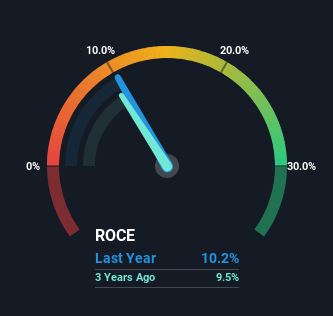- Japan
- /
- Retail Distributors
- /
- TSE:2733
Returns On Capital Are Showing Encouraging Signs At Arata (TSE:2733)

If we want to find a potential multi-bagger, often there are underlying trends that can provide clues. Firstly, we'd want to identify a growing return on capital employed (ROCE) and then alongside that, an ever-increasing base of capital employed. Ultimately, this demonstrates that it's a business that is reinvesting profits at increasing rates of return. With that in mind, we've noticed some promising trends at Arata (TSE:2733) so let's look a bit deeper.
Understanding Return On Capital Employed (ROCE)
For those that aren't sure what ROCE is, it measures the amount of pre-tax profits a company can generate from the capital employed in its business. To calculate this metric for Arata, this is the formula:
Return on Capital Employed = Earnings Before Interest and Tax (EBIT) ÷ (Total Assets - Current Liabilities)
0.10 = JP¥15b ÷ (JP¥353b - JP¥204b) (Based on the trailing twelve months to December 2024).
Therefore, Arata has an ROCE of 10%. On its own, that's a standard return, however it's much better than the 6.6% generated by the Retail Distributors industry.
Check out our latest analysis for Arata

Above you can see how the current ROCE for Arata compares to its prior returns on capital, but there's only so much you can tell from the past. If you'd like to see what analysts are forecasting going forward, you should check out our free analyst report for Arata .
How Are Returns Trending?
The trends we've noticed at Arata are quite reassuring. Over the last five years, returns on capital employed have risen substantially to 10%. The company is effectively making more money per dollar of capital used, and it's worth noting that the amount of capital has increased too, by 32%. So we're very much inspired by what we're seeing at Arata thanks to its ability to profitably reinvest capital.
On a separate but related note, it's important to know that Arata has a current liabilities to total assets ratio of 58%, which we'd consider pretty high. This can bring about some risks because the company is basically operating with a rather large reliance on its suppliers or other sorts of short-term creditors. While it's not necessarily a bad thing, it can be beneficial if this ratio is lower.
Our Take On Arata's ROCE
A company that is growing its returns on capital and can consistently reinvest in itself is a highly sought after trait, and that's what Arata has. And investors seem to expect more of this going forward, since the stock has rewarded shareholders with a 54% return over the last five years. In light of that, we think it's worth looking further into this stock because if Arata can keep these trends up, it could have a bright future ahead.
Like most companies, Arata does come with some risks, and we've found 1 warning sign that you should be aware of.
For those who like to invest in solid companies, check out this free list of companies with solid balance sheets and high returns on equity.
New: Manage All Your Stock Portfolios in One Place
We've created the ultimate portfolio companion for stock investors, and it's free.
• Connect an unlimited number of Portfolios and see your total in one currency
• Be alerted to new Warning Signs or Risks via email or mobile
• Track the Fair Value of your stocks
Have feedback on this article? Concerned about the content? Get in touch with us directly. Alternatively, email editorial-team (at) simplywallst.com.
This article by Simply Wall St is general in nature. We provide commentary based on historical data and analyst forecasts only using an unbiased methodology and our articles are not intended to be financial advice. It does not constitute a recommendation to buy or sell any stock, and does not take account of your objectives, or your financial situation. We aim to bring you long-term focused analysis driven by fundamental data. Note that our analysis may not factor in the latest price-sensitive company announcements or qualitative material. Simply Wall St has no position in any stocks mentioned.
About TSE:2733
Arata
Engages in the wholesale of daily goods, cosmetics, household goods, pet supplies, and others in Japan.
Undervalued with solid track record.
Market Insights
Community Narratives


